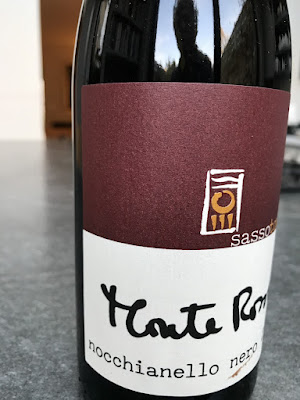As a coda to our visit to Florence last month, a genuine discovery: Nocchianello Nero.
Walking by a not especially auspicious wine shop we entered and fondled a few predictable bottles, passing over this one.
When faced with different terms it is difficult to separate out what might be the trade name, the name of the vineyard, the village or 'ldit' or the grape variety. We are used to labels not mentioning the latter so we are always suspicious of names purporting to be of grape varieties we have never heard of.
Also suspicious are any claims that the winemerchant may make for the grape variety being unique. Too many times have we bought wines with intriguing names of unfamiliar grape varieties only to find out that they are synonyms for Syrah or something.
 |
| Sorano |
So faced with the front and back labels on this bottle not giving much away we moved on to others. The only name we recognised was Sorano, known as the Citta del Tufo after the volcanic stone from which it is built.. We had been there. It's a lovely unspoiled little town in an out of the way corner of Western Tuscany, not far from Pitigliano. It's actually in the province of Grosseto and is considered part of the Maremma. Population around 3,400.
The kind lady at the till (cash only because the card machine wasn't working) assured us that Nocchianello Nero was a stand-alone rare grape variety. Indeed, on closer inspection a claim that was suggested on the back label;
Nocchianello Nero, vitigno della citta del Tufo, dai nostri vigneti vulcanici a Sorana prende il nome dal vulcano vulsineo de Monte Rosso.
Nochianello Nero has no mention in Wine Grapes as it is rarely made into a monovarietal wine for commercial purposes. More surprisingly it has also passed under the radar of 'Native Wine Grapes of Italy' (D'Agata) and even Galet (Dictionnaire Encyclopedique des Cepages).
Most gratifying but it makes you wonder how many more uber-obscure varieties are out there.
It's worth adding a note about the winery Sassotondo and Carla Benini mentioned on the label. Sassotondo seems to be a most interesting and serious operation. In particular we were impressed by Sra. Benini's work with Ciliegiolo - a grape we have been havong difficuly coming to terms with. At Sassotondo they are experimenting with different plantings and vinifications of this variety.
 |
| Carla Benini, Is that a bunch of Nocchianello Nero? |
In addition, Sassotondo has a broad palette of grape varieties either grown by themselves or by friends in the region. these include
Greco, Sauvigno Blanc, Trebbiano, Viognier for the whites
Ciliegiolo, Merlot, Nocchianello Nero, Sangiovese, Teroldego for the reds.
The Sassotondo website has the following information on Nocchianello Nero:
Nocchianello Nero is the name of an ancient grape of Pitigliano and
surroundings. It is truly autochthonous with no known genetic
relationship to other grapes.
We have brought it back to
cultivation in 2010, starting from the old vine varieties collected by
the CREA of Arezzo, a research institute specializing in viticulture; in
the 70s they gathered all the vine genetics they could find in the old
vineyards of the area.
We also found a few nocchianello
vines in the old San Lorenzo vineyard and so we grafted a few rows with
it.
The nocchianello nero vine is
quite vigorous; the mature leaf is thick and resembles the fig leaf and
the sprouts are long. Somehow it looks like a plant apt to be trained as
a pergola.
The grapes ripe late, at least 10
days after sangiovese and this can be quite interesting in this crazy
weather when everything gets ripe too early: a better expression of the
aroma can be achieved when the temperatures are not too high in the last
ripening phase.
The grapes are beautiful, very
pruinose, hard and crispy. The sugar intake is good, and the acidity
remains at a good level. It is not very coloured. We have made small
vinifications starting in 2011 and now finally vintage 2019 has been
released.
The wine is red ruby, bright, of medium intensity. The aroma displays spicy notes, white pepper, cassis, nutmeg with a not of something wild. In the mouth it is medium bodied, with good acidity and non-aggressive tannins, good aromatic persistence ant tons of ground pepper.
NB. The Vulsini volcano complex is described as follows;
The Vulsini volcanic complex in central Italy covers about 2,200 km2
at the northern end of the Roman Magmatic Province. Following lava
extrusion and explosive eruptions that constructed the main complex, the
16-km-wide, lake-filled Bolsena caldera on the east and the 8 x 11 km
Latera caldera on the west were formed during major Pleistocene
explosive eruptions at about 0.3 and 0.16 million years ago,
respectively. Five major Plinian fall deposits were erupted from vents
at or near Latera caldera during the late Pleistocene. The latest major
eruption formed unwelded pumice flows and welded airfall tuffs of the
Pitigliano Formation, associated with collapse of the Vepe caldera about
166,000 years ago at the NW end of Latera caldera. Post-caldera
volcanism produced scoria cones and lava flows from vents within and to
the west of Latera caldera. Youthful-looking remnants of ash cones in
Lake Bolsena may have given rise to a legend of a pre-historical
fire-god, Volta. An historical report noted that "a flame shot up near
Volsini" in 104 BCE.



1 comment:
Nocchianello Nero is listed in the Vitis International Variety Catalogue.
Post a Comment